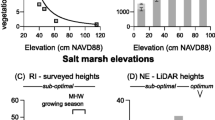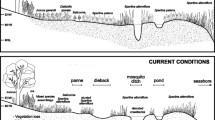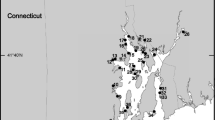Abstract
Field studies and aerial photograph interpretation suggest that large sections of Jamaica Bay salt marshes in New York City near John F. Kennedy International Airport are deteriorating rapidly. The relatively recent salt marsh losses may be caused by a variety of factors, potentially interacting synergistically. Possible factors include reduced sediment input, dredging for navigation channels, boat traffic, and regional sea-level rise. Field work included aboveground biomass measurements of Spartina alterniflora, mapping plant community distribution, and documenting biogeomorphological indicators of marsh loss. Current productivity (standing crop biomass), which ranged from approximately 700 to 1500 g m−2, was typical of healthy marshes in this region, in spite of other indicators of marsh degradation. Historical aerial photographs of several islands showed that sampled marshes have diminished in size by ≈12% since 1959. Overall island low marsh vegetation losses since 1974 averaged 38%, with smaller islands losing up to 78% of their vegetation cover. Ground observations indicate that major mechanisms of marsh loss include increased ponding within marsh interiors, slumping along marsh edges, and widening of tidal inlets. Projections of future sea-level rise, using outputs from several global climate models and data from local tide gauges, in conjunction with a range of plausible accretion rates, suggest that under current stresses, Jamaica Bay salt marshes are unlikely to keep pace with accelerated rates of sea-level rise in the future.
Similar content being viewed by others
Literature cited
Allen, J. R. L. and K. Pye. 1992. Coastal saltmarshes: their nature and importance. p. 1–18. In J. R. L. Allen and K. Pye (eds.) Saltmarshes: Morphodynamics, Conservation and Engineering Significance. Cambridge University Press, Cambridge, UK.
Anisfeld, S. C., M. J. Tobin, and G. Benoit. 1999. Sedimentation rates in flow-restricted and restored salt marshes in Long Island Sound. Estuaries 22:231–244.
Bertness, M. D. 1991. Zonation of Spartina patens and Spartina alterniflora in a New England salt marsh. Ecology 72:138–148.
Bertness, M. D. and A. M. Ellison. 1987. Determinants of pattern in a New England salt marsh community. Ecological Monographs 57:129–147.
Black, F. R. 1981. Jamaica Bay: a history. Study No. 3, Division of Cultural Resources, North Atlantic Regional Office, National Park Service, U.S. Department of the Interior, Washington, DC, USA.
Boesch, D. F., M. N. Josselyn, A. J. Mehta, J. T. Morris, W. K. Nuttle, C. A. Simenstad, and D. J. P. Swift. 1994. Scientific assessment of coastal wetland loss, restoration and management in Louisiana. Journal of Coastal Research Special Issue No. 20.
Boumans, R. M. J. and J. W. Day, Jr. 1993. High precision measurements of sediment elevation in shallow coastal areas using a sedimentation-erosion table. Estuaries 16:375–380.
Bricker-Urso, S., S. W. Nixon, J. K. Cochran, D. J. Hirschberg, and C. Hunt. 1989. Accretion rates and sediment accumulation in Rhode Island salt marshes. Estuaries 12:300–317.
Burger, J. and J. Shisler. 1983. Succession and productivity on perturbed and natural Spartina salt marsh areas in New Jersey. Estuaries 6:50–56.
Cademartori, E. A. 2000. An assessment of salt marsh vegetation changes in southern Stony Brook Harbor: implications for future management. M.A. Thesis. Marine Environmental Science, State University of New York, Stony Brook, NY, USA.
Cahoon, D. R. and Reed, D. J.. 1995. Relationships among marsh surface topography, hydro period, and soil accretion in a deteriorating Louisiana salt marsh. Journal of Coastal Research 11:357–369.
Cochran, J. K., D. J. Hirshberg, J. Wang, and C. Dere. 1998. Atmospheric deposition of metals to coastal waters (Long Island Sound, New York, USA.): Evidence from saltmarsh deposits. Estuarine, Coastal and Shelf Science 46:503–522.
Dean, R. G., A. R. Dalrylmple, R. W. Fairbridge, S. P. Leatherman, D. Nummedal, M. P. O’Brien, O. H. Pilkey, W. Sturges III, and R. L. Wiegel. 1987. Responding to Changes in Sea Level: Engineering Implications. National Academy Press, Washington, DC, USA.
DeLaune, R. D., J. A. Nyman, and W. H. Patrick, Jr. 1994. Peat collapse, ponding and wetland loss in a rapidly submerging coastal marsh. Journal of Coastal Research 10:1021–1030.
Downs, L. D., R. J. Nicholls, S. P. Leatherman, and J. Hautzenroder. 1994. Historic evolution of a marsh island: Bloodsworth Island, Maryland. Journal of Coastal Research 10:1031–1044.
Englebright, S. 1975. Jamaica Bay: a Case Study of Geo-Environmental Stresses: a Guidebook to Field Excursions. New York State Geological Association, Hofstra University, Hempstead, NY, USA.
Fallon D. and F. Mushacke. 1996. Tidal Wetlands Trends in Shinnecock Bay, New York 1974 to 1995. Division of Fish, Wildlife and marine Resources, New York State Department of Environmental Conservation, East Setauket, NY, USA.
Franz, D. 1997. Resource allocation in the intertidal salt marsh mussel Geukensia demissa in relation to shore level. Estuaries 20:134–148.
Gomitz, V. 1995. Monitoring sea level changes. Climatic Change 31:515–544.
Gomitz, V. 2001. Sea-level rise and coasts. p. 21–46. In C. Rosenzweig and W. Solecki (eds.) Climate Change and a Global City the Potential Consequences of Climate Variability and Change Metro East Coast. Report for the U.S. Global Change Research Program, National Assessment of the Potential Consequences of Climate Variability and Change for the United States. Columbia Earth Institute, New York, NY, USA.
Gornitz, V., S. Couch, and E. K. Hartig. 2001. Impacts of sea level rise in the New York City metropolitan area. Global and Planetary Change 32:61–88. Elsevier Science, Amsterdam, The Netherlands.
Hart, T. F. and A. S. Milliken. July 1992. Significant Coastal Fish and Wildlife Habitats Program: a part of the New York Coastal Management Program and New York City’s approved Waterfront Revitalization Program. New York State Department of State, Division of Coastal Resources and Waterfront Revitalization. Albany, NY, USA.
Hartig, E. K., A. Kolker, D. Fallon, and F. Mushacke. 2001. Wetlands. p. 67–86. In C. Rosenzweig and W. Solecki (eds.) Climate Change and a Global City: the Potential Consequences of Climate Variability and Change-Metro East Coast. Report for the U.S. Global Change Research Program, National Assessment of the Potential Consequences of Climate Variability and Change for the United States. Columbia Earth Institute, New York, USA.
IPCC 2001. Chapter 11. p. 639–693. In J. T. Houghton, Y. Ding, D. J. Griggs, M. Noguer, P. J. van der Linden, X. Day, K. Maskell, and C. A. Johnson (eds.) Climate Change 2001: The Scientific Basic. Cambridge University Press, Cambridge, UK.
Kana, T. W. 1995. A mesoscale sediment budget for Long Island, New York. Marine Geology 126:87–110.
Kana, T. W., W. C. Eiser, B. J. Baca, and M. L. Williams. 1988. New Jersey case study. p. 61–86. In J.G. Titus. Greenhouse Effect, Sea-Level Rise and Coastal Wetlands. USEPA Office of Policy, Planning and Evaluation, Washington, DC, USA. USEPA 230-05-86-013.
Kearney M. S. 1996. Sea-level change during the last thousand years in Chesapeake Bay. Journal of Coastal Research 12:977–983.
Liberman, L. and D. M. Peteet. 2001. Paleoenvironmental history of Jo Co Marsh, Jamaica Bay, New York. EOS. Transactions of the American Geophysical Union 82:S87.
MacKenzie, C. L. Jr. 2000. The abundance of small invertebrates in relation to sea lettuce, Ulva lactuca, mats. Bulletin, New Jersey Academy of Sciences 45:13–17.
NYCDEP. 2000. 1999 New York Harbor Water Quality. New York City Department of Environmental Protection, New York, NY, USA.
NYSDEC. 2000. New York State Department of Environmental Cosservation. Albany, NY, USA. www.dec.state.ny.us/website/dfwmr/marine/twloss.html.
Nixon, S. W. and C. A. Oviatt. 1973. Analysis of local variation in the standing crop of Spartina alterniflora. Botanica Marina 16:103–109.
Nuttle, W. K. 1997. Conserving coastal wetlands despite sea-level rise. EOS Transactions of the American Geophysical Union 78:257, 260–261.
Nydick, K. R., A. B. Bidwell, E. Thomas, and J. C. Varekamp. 1995. A sea-level rise curve from Guilford, Connecticut, USA. Marine Geology 124:137–159.
Orson R. A., R. S. Warren, and W. A. Niering. 1998. Interpreting sea-level rise and rates of vertical marsh accretion in a southern New England tidal salt marsh. Estuarine and Coastal Shelf Science 47:419–429.
Orson, R. A., W. Panageotou, and S. P. Leatherman. 1985. Response of tidal salt marshes of the U.S. Atlantic and Gulf Coasts to rising sea levels. Journal of Coastal Research 1:29–38.
Peteet, D. M. and L. Liberman. 2001. Millennial climate and land use history from Jamaica Bay marshes, New York. Geological Society of America Annual Meeting, Abstracts with Programs 33: A-453.
Redfield, A. C. 1972. Development of a New England salt marsh. Ecological Monographs 42:201–237.
Reed, D. J. 1995. The response of coastal marshes to sea-level rise: survival or submergence? Earth Surface Processes and Landforms 20:39–48.
Richard, G. A. 1978. Seasonal and environmental variations in sediment accretion in a Long Island salt marsh. Estuaries 1:29–35.
Rosenzweig, C. and W. Solecki (eds.). 2001. Climate Change and a Global City: the Potential Consequences of Climate Variability and Change-Metro East Coast. Report for the U.S. Global Change Research Program, National Assessment of the Potential Consequences of Climate Variability and Change for the United States. Columbia Earth Institute, New York, NY, USA.
Tanacredi, J. T. and C. J. Badger. 1995. Gateway, a Visitor’s Companion. Stockpile Books, Mechanicsburg, PA, USA.
Teal, J. and M. Teal. 1969. Life and Death of the Salt Marsh. Ballantine Books, New York, NY, USA.
Teal, J. M. and B. L. Howes. 1996. Interannual variability of a salt marsh ecosystem. Limnology and Oceanography 41:802–809.
Thomas, E. and J. C. Varekamp. 1991. Paleo-environmental analysis of marsh sequences (Clinton, Connecticut): evidence for punctuated rise in relative sea level during the latest Holocene. Journal of Coastal Research Special Issue 11:125–158.
Tiner, R. W. 1987. A Field Guide to Coastal Wetland Plants of the Northeastern United States. The University of Massachusetts Press. Amherst, MA, USA.
Titus, J. G. 1988. Greenhouse Effect, Sea Level Rise and Coastal Wetlands. USEPA Office of Policy, Planning, and Evaluation, Washington, DC, USA. EPA-230-05-86-013.
Udell, H., F. J. Zarudsky, T. E. Doheny, and P. R. Burkholder. 1969. Productivity and nutrient values of plants growing in the salt marshes of the Town of Hempstead, Long Island. Bulletin of the Torrey Botanical Club 96:42–51.
Varekamp, J. C., E. Thomas, and O. Van de Plassche. 1992. Relative sea-level rise and climate change over the last 1500 years. Global Change, Special Issue: Terra Nova 4:293–304.
Varekamp, J. C. and E. Thomas. 1998. Climate change and the rise and fall of sea level over the millennium. EOS. Transactions of the American Geophysical Union 79:69, 74–75.
Warren, R. S. and W. A. Niering. 1993. Vegetation change on a northeast tidal marsh: interaction of sea-level rise and marsh accretion. Ecology 74:96–103.
Wells, J. V. 1998. Important Bird Areas of New York State. New York State Office of National Audubon Society, Albany, NY, USA.
Wray, R. D., S. P. Leatherman, and R. J. Nicholls. 1995. Historic and future land loss for upland and marsh islands in the Chesapeake Bay, Maryland, USA. Journal of Coastal Research 11:1195–1203.
Zeppie, C. R. 1977. Vertical profiles and sedimentation rates of Cd, Cr, Cu, Ni, and Pb in Jamaica Bay, New York. M.S. Thesis. Marine Environmental Sciences Program, State University of New York, Stony Brook, NY, USA.
Zhang, K., B. C. Douglas, and S. P. Leatherman. 2000. Twentieth-century storm activity along the U.S. East Coast. Journal of Climate 13:1748–1761.
Author information
Authors and Affiliations
Corresponding author
Rights and permissions
About this article
Cite this article
Hartig, E.K., Gornitz, V., Kolker, A. et al. Anthropogenic and climate-change impacts on salt marshes of Jamaica Bay, New York City. Wetlands 22, 71–89 (2002). https://doi.org/10.1672/0277-5212(2002)022[0071:AACCIO]2.0.CO;2
Received:
Revised:
Accepted:
Issue Date:
DOI: https://doi.org/10.1672/0277-5212(2002)022[0071:AACCIO]2.0.CO;2




